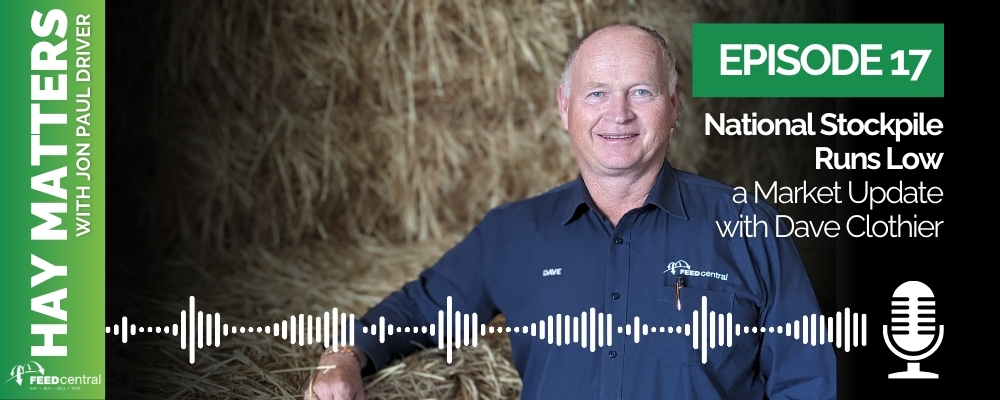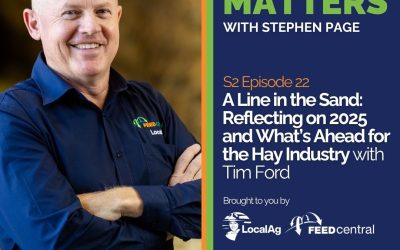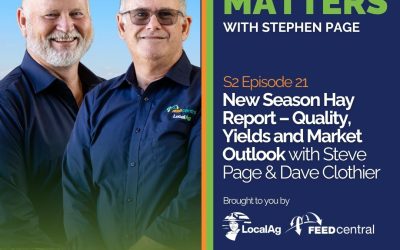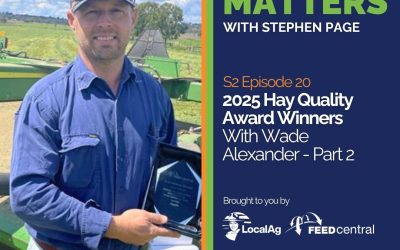
Jon Paul Driver catches up with National Sales Manager Dave Clothier for a hay market report and an indepth discussion on the current status of the national hay market ahead of new season. While Southern Queensland has seen good early-season hay production, and early harvesting in New South Wales promises high yields, dry conditions in South Australia and Western Victoria are expected to lead to lowered production. With much of the 2022 hay stock now gone, and high fodder demand, this is the idea time to fill the sheds.
- The national stockpile of hay is largely depleted, with existing supplies either committed for domestic use or export. Price stability is expected by late October to early November as the status of the stockpile becomes clearer.
- In southern Queensland, there’s been substantial hay production due to favourable early-season weather. Meanwhile, New South Wales has hay prematurely on the ground, and regions like the Darling Downs are experiencing unusually high yields and early harvests.
- In contrast, South Australia and Western Victoria face reduced yields due to ongoing dry conditions, affecting overall availability.
- With grain prices decreasing and cattle numbers on the rise, fodder demand is leading more farmers to turn to hay production to capitalise on the fodder market.
- Hay is only made for 90 days, but cattle eat 365 days a year, and this is the ideal time to fill sheds with high quality feed in preparation for upcoming demand.
Read Transcript
Jon Paul Driver 0:00
Welcome to the Feed Central Hay Matters podcast, your go to source for all things hay related in Australia. I’m your host, Jon Paul driver, and today we’re joined by Dave Clothier. Dave’s the National Sales Manager for Feed Central. Today we’re going to do a market update. Let’s start in Queensland.
Dave Clothier 0:23
Thanks. JP, great to have a yarn again, mate. Yeah, lots changed since we last spoke. There’s been quite a bit of hay made in the north and a lot of hay sitting on the ground in New South Wales. But we can run through the whole country, if you like. Yeah, I go. I’ve just, I’ve just met the last few days out on the Darling Downs in South East Queensland, with one of our sales guys, went and visited growers and contractors just to get a real understanding of what’s going on out there. It’s an early season. There’s very favorable conditions in southern Queensland. We’ve had some hot, dry weather just recently, in the mid 30s Celsius wise, so pretty warm for this time of year. So there has been a lot of hay made just locally, which has been consumed by local graziers and buyers across southern Queensland and a bit north of there, to be honest. So most of that’s gone. There’s still, there’s still a bit to go for some of those crops that were sown later. But there’s a lot of talk just about the best season that people can remember, young or old that we spoke to. Like the grain crops are just tremendous, huge yields going to be forecast coming out of there. And that’s led to an early high season, of course, talk of stripping barley at the end of this week, which is about a month earlier to where it normally is. So things have changed. A couple of weeks ago, like the price conversation was a whole different one than what it is today. In the last two weeks, grain prices have tumbled. That’s had an effect on fodder pricing. Obviously, that follows closely behind it at this time of year. So that’s all very interesting to appreciate. And then when we move further south into Central New or northern and central New South Wales, a lot of that hay is on the ground in Windrose as we speak right now, early for those guys as well, and there’ll be some pretty good yields out of those areas, like, you know, there’s, there’s five or six ton to the hectare, sort of numbers for fodder production in a lot of the areas we’re in, which is pretty handy, pretty handy yields, I can tell you. So that’s all good and good quality too. What’s been produced so far, you know, we’ve had a break in the weather, so it’s allowed for some good haymaking conditions through Central New South Wales. It’s happening as we speak, and still yet to come. Of course, when we move further south into Victoria, they’ve still got a ways to go. But the real challenge of that the dry that’s continued through South Australia and Western Victoria is certainly going to have an effect on their yields. Their yields will be well back, talking to some guys from where they were getting sort of eight tons of the heck there are going to be back to three and four so, and they’re pretty damn the dumps. Those guys down there, it’s nearly too late for them to expect any more than that. But the cause and effect of that, of course, is what’s going to happen is that really safe southern hay producing area is not going to have a lot of supply, and that area largely will become buyers rather than sellers. So when we talk about New South Wales and hay production there, particularly in the southwest corner, where there’s been a lot of hay made and bean made, as we speak, that could well move north and south, where in the past, it’s probably just gone north because of that continuing dry and the seasonal outlook for those guys. So that’s all that will all play into it. And then, of course, we’ve got the exporters like there’s still a pretty strong export demand.
Jon Paul Driver 4:13
The export industry is focused in Victoria and South Australia, and then, of course, over in WA. But what’s the outlook on the exporters?
Dave Clothier 4:23
Well, they’re still looking for volume, but I understand that they’ll be looking at lower grades of hay as well as those top lines of hay to fill the supply chain. I think I could only suggest that, because South Australia’s yields are well back, that they will travel further north to secure volume. Logic would tell me that, but I think we just got to wait and see. Like the reality is, you know, there’s been some fluctuation in prices for local made product. I’m talking about Southern Queensland, and that will have an effect as we go further south to a degree. Three. But I think the reality is that the stockpile is gone, you know, through the supplying South Australia and Victoria. So I think, you know, there’s two options for buyers that I see, depending on the volume they need. Like, it’s a good time to buy right now, because prices are pretty attractive at the moment, from a buying perspective, and the quality’s there. But I I don’t think the prices will truly stabilize until we understand what that national stockpile looks like, which will be towards the end of October and the start of November. The stockpile is largely gone. That’s that’s the big one, although people might travel around and see hay sitting in sitting in sheds like they need to appreciate that that’s already contracted, whether it be exported or domestically, it’s secured. You know what can transpire between here and November on quality? We’ll just have to wait and see what how the season plays out and what weather effects happen across certain areas. But we’ve sort of seen over recent times that all grades of hay are selling, which is really exciting, and we’ve got a really strong message, particularly to our growers, that there’s a there’s a real need to fill the sheds. Because the reality is, you know, the hay making season is really spread over 90 days. But, you know, our livestock are eating 365, days of the year, so we just need to take the blinkers off and think about it a bit more. Another conversation we’re having with growers is just talking about bail weights and the advantages of moving over distances. You know, high bar weights can Gen generally attract a higher Rex farm price? Because we’re getting maximum loads and over distance, both buyer and seller are winners. Okay,
Jon Paul Driver 6:49
A question on grain versus hay, I’m sitting in the US looking at terrible grain prices, absolutely terrible. What’s the sentiment among those producers that have the option?
Dave Clothier 7:01
Well, depends. If we’re talking about up where I’m living, in southern Queensland, what the window to make that call on, on hay versus Graham is just about shut. It’s over. So, so they’ve pretty much done the job. When we get down into New South Wales and below, like they are hedging their bets. There’s still they’ve still got some time to make some decisions which way they’re going to go. Grain right now has come back considerably, and fodder production is certainly will yield a higher return. There’s no doubt about that. In light of that, we just need to be careful. The one thing that I’m telling growers, if they’ve got sheds, fill them, anything outside the sheds is a bit of their own risk, because we haven’t got a crystal ball. We can’t tell what’s going to happen, but the fact that the stockpile is just about depleted means we need a lot of hay made. And if we talk about demand really quickly, because this, this is the one a lot of people aren’t aware of, like, we’ve got a record number of cattle again on feed every month. It’s a new record. So I’ve got 1.4 million on feed right now. And expansion still going on, and with grain prices coming down, feeding cattle is going to be very attractive, and that’s nothing but music to our ears in the fodder industry, because while they’re feeding those numbers of cattle, they need hay. So that’s, that’s one, you know, and our beef herd is pretty stable. It’s back about a percent, which is, which is nothing, really. The female retention rate is still growing in the north, or the breeder herd is growing in the north through a number of good wet seasons. And we know that’s where the majority cattle are in the South. It’s gone down slowly your own herd over there, like you’re in the rebuild phase or about to begin that, and you guys are going to struggle to supply your own domestic market, which opens the door to for export, Australian beef, from an export perspective, for Australian red meat, it’s looking pretty damn good going forward. In my view, something
Jon Paul Driver 9:16
I don’t get to ask about very often is the ovarian side of the world. What sheep look like? Sheep?
Dave Clothier 9:22
Okay, our flock at the moment is about 76 million, or 76 and a half to be exact. It’s back about 3% over the national flock, that is. But land production has actually gone up 9% interestingly enough, mutton’s gone up by about 3% and the forecast for the rest of the year, and going into 25 is the flocks going to stabilize, to be to remain above the 10 year average. So it’s pretty healthy in in that field
Jon Paul Driver 9:56
as well. And then to dairy, dairy milk
Dave Clothier 9:59
per day. Is slightly lower than last year. Demand is expected to remain pretty steady, as being forecasters and forecasted and prices are down from from record highs, but they’re still pretty healthy. Dairy is very healthy. But what that means, I think, is, you know, lower farm gate prices will pressure farm profitability and in do and say, you know, feed tests results will drive purchase decisions. So people are getting smarter in that dairy sector particularly, but we also see that across the beef sector as well. People are getting smarter. They’re starting to understand how to read a quality certificate and tailoring, you know, the right product to suit their needs, versus price.
Jon Paul Driver 10:43
We talked bovine ovine export. We talked grain versus hay. The production season is ramping up. Well, unless you’re in Queensland, then you’re might be almost done. This actually feels optimistic. There’s demand, there’s not. The production site is a little bit questionable, but in terms of demand and pricing, this sounds optimistic. Am I missing the tone?
Dave Clothier 11:08
No, no, I’m super optimistic. Like as long as those mouths to feed, there’s a need for fodder, and we’ve got as many mouths in the livestock industry in Australia today as we’ve ever had. So demand is pretty secure. In my book, we’ve got at the stockpile of that 22 weather damage product is gone like the opportunity to fill it with new season high is red hot. And I’d suggest anybody who’s got the opportunity, they should be doing exactly that, fill in their sheds. We’ve, we’re still in the start of September. There’s still time for a lot of growers, particularly across the larger growing areas, being Southern, New South Wales, Victoria in particular, that they can still make the call hay versus grain. And with grain prices going down, I think it’s looking fairly attractive. That’s what I’m hearing from growers. Beyond that, the other thing, yeah, we are in the start of September, so there is, there is still a real chance of frosted crops.
Jon Paul Driver 12:09
That’s a deciding factor, right? That’s
Dave Clothier 12:11
another absolute winner in this fodder space. When the stockpile is so challenged at the moment, that’s, that’s the ace up our sleeve that
Jon Paul Driver 12:20
would swing the tides to fodder production almost instantly in regions affected by frost. Yeah,
Dave Clothier 12:28
absolutely.
Jon Paul Driver 12:29
Dave, thanks for giving us your thoughts today. As usual,
Dave Clothier 12:32
no worries at all. JP, very exciting time of the year. Again,
Jon Paul Driver 12:36
Again, I’ve been joined by Dave Clothier, National Sales Manager for Feed Central. This podcast is proudly presented by Feed Central. Stay tuned in for our upcoming episodes.



